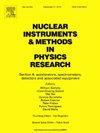Detection of ionization electrons with hybrid pixel detectors for non-destructive beam profile measurements
IF 1.4
3区 物理与天体物理
Q3 INSTRUMENTS & INSTRUMENTATION
Nuclear Instruments & Methods in Physics Research Section A-accelerators Spectrometers Detectors and Associated Equipment
Pub Date : 2025-07-19
DOI:10.1016/j.nima.2025.170845
引用次数: 0
Abstract
The Beam Gas Ionization (BGI) profile monitor is an Ionization Profile Monitor used for continuous, non-destructive transverse beam profile measurements in synchrotrons at CERN. Electrons are produced when residual gas in the beam pipe is ionized by the proton or ion beams orbiting the particle accelerator. In the BGI profile monitor, these ionization electrons are accelerated onto Timepix3-based silicon hybrid pixel detectors using co-linear electric and magnetic fields. Individual electrons are detected and subsequently summed to reconstruct the beam’s transverse profile. The energy absorption of the 8.6 keV ionization electrons in the sensor layers of the detectors induces electrical signals close to or below the noise floors of the Timepix3’s digitizers. This results in hyper-sensitivity of the detection efficiency to small changes in the detectors’ global thresholds, as demonstrated in simulations, and creates challenges for the equalization of detection efficiency across all four detectors in each BGI instrument. This equalization is necessary to utilize the full field-of-view of the instrument. Emittance measurements from an equalized BGI profile monitor are compared to measurements from Beam Wire Scanners and show good agreement. This constitutes the first validation of the primary use case of the BGI profile monitor.
非破坏性光束轮廓测量用混合像素检测器检测电离电子
束流气体电离(BGI)剖面监测仪是一种电离剖面监测仪,用于在欧洲核子研究中心同步加速器中进行连续的、非破坏性的横向束流剖面测量。当束流管中的残余气体被绕粒子加速器运行的质子或离子束电离时,就会产生电子。在华大基因剖面监视器中,利用共线性电场和磁场将这些电离电子加速到基于timepix3的硅混合像素探测器上。单个电子被检测并随后被求和以重建光束的横向轮廓。探测器传感器层中~ 8.6 keV电离电子的能量吸收诱导电信号接近或低于Timepix3数字化仪的噪声底。如模拟所示,这导致检测效率对探测器全局阈值的微小变化超敏感,并为每个华大基因仪器中所有四个探测器的检测效率均衡带来挑战。这种均衡是必要的,以利用仪器的全视野。均衡化BGI剖面监视器的发射度测量值与波束线扫描仪的测量值进行了比较,显示出良好的一致性。这构成了对BGI配置文件监视器的主要用例的第一次验证。
本文章由计算机程序翻译,如有差异,请以英文原文为准。
求助全文
约1分钟内获得全文
求助全文
来源期刊
CiteScore
3.20
自引率
21.40%
发文量
787
审稿时长
1 months
期刊介绍:
Section A of Nuclear Instruments and Methods in Physics Research publishes papers on design, manufacturing and performance of scientific instruments with an emphasis on large scale facilities. This includes the development of particle accelerators, ion sources, beam transport systems and target arrangements as well as the use of secondary phenomena such as synchrotron radiation and free electron lasers. It also includes all types of instrumentation for the detection and spectrometry of radiations from high energy processes and nuclear decays, as well as instrumentation for experiments at nuclear reactors. Specialized electronics for nuclear and other types of spectrometry as well as computerization of measurements and control systems in this area also find their place in the A section.
Theoretical as well as experimental papers are accepted.

 求助内容:
求助内容: 应助结果提醒方式:
应助结果提醒方式:


